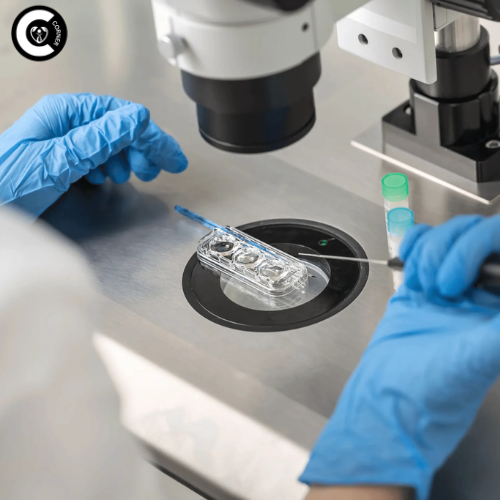Your semen is a complicated biological cocktail that acts as a health report card for your whole male reproductive system, not only reproductive fluid. When looked at properly, seminal fluid can reveal hidden fertility issues, hormonal imbalances, and even early signs of health problems that might go unnoticed for years. Until they encounter problems conceiving, many guys live oblivious of the essential knowledge included in every ejaculation. Understanding seminal fluid analysis gives you the ability to proactively track your reproductive health instead of responding to issues after they surface. In our contemporary society, where environmental pollutants, lifestyle choices, and late fatherhood are contributing to the growing prevalence of male fertility issues, this information is especially vital.
What is seminal fluid analysis?
A complex laboratory test called seminal fluid analysis assesses the qualitative and quantitative components of your sperm and semen. The test consists of three main parts that together provide a complete picture of your fertility possibilities. First, it evaluates sperm concentration, which gauges how many million sperm are present per millilitre of semen—a vital factor since higher numbers raise the likelihood of successful conception. Second, it assesses sperm motility, or how well and how forcefully your sperm swim towards their target. High sperm counts are meaningless even if the sperm cannot move correctly. Third, it looks at sperm morphology, or the proportion of sperm with absolutely normal forms, since abnormally shaped sperm usually cannot successfully fertilize an egg. Modern laboratories have advanced computer-assisted systems tracking individual sperm movements and detecting minute abnormalities that older techniques might overlook, from basic manual counting under microscopes.
Also Read: Learn About Thick Semen
Reasons to Get Seminal Fluid Analysis
Although many guys only think about semen testing when they have fertility issues, there are several good arguments to get examined aggressively. A baseline semen study can help couples planning pregnancy find possible obstacles before they cause months of disappointment and frustration. The test lets men undergoing cancer treatments that could affect fertility know whether they should store sperm first. Many athletes and bodybuilders on performance-enhancing drugs are unaware that these chemicals can significantly lower natural sperm production until it is too late. The study can also find hidden health problems; for example, low semen volume could point to a blockage or issue with the seminal vesicles, and poor motility could point to chronic inflammation or infection. Semen quality is a key indicator of general health, even for men not intending to have children; studies have shown links between low semen characteristics and higher chances of particular cancers and heart disease.
Warning Signs You Need Seminal Fluid Analysis
Some symptoms call for quick semen testing to reveal possible health or fertility problems. These red flags should not be ignored:
Physical Symptoms Requiring Testing
- Painful ejaculation could point to blockages or prostatitis-related problems.
- Blood in semen (hematospermia) could be harmless, but calls for further research.
- Unusual sperm texture, Strangely thick or gelatinous, Watery texture, Grainy or lumpy look
Fertility Concerns
- Failed conception after 6-12 months of unprotected sex
- Male factors contribute to 50% of infertility cases – testing both partners is essential
- Men over 35 planning pregnancy (higher risk of sperm DNA fragmentation)
The Shocking Truth About Sample Collection
Good sample gathering determines accurate results; nonetheless, many men forgo their tests because of poor preparation. Reflecting a careful balance, the needed 3-5 days of abstinence before testing may not allow sufficient sperm accumulation; lengthier abstinence might increase the percentage of dead or dying sperm in the sample. Days before testing, lifestyle decisions are crucial: alcohol usage can lower sperm motility, hot tub or tight trousers heat exposure can impair growing sperm, and even some medicines might temporarily change results. Though some hospitals provide at-home collection kits, they pose significant risks: semen starts to decay rapidly after ejaculation, and temperature variations during delivery can harm fragile sperm, hence generating erroneous, bad results. The gold standard involves producing the sample in a secluded room at the testing location, where it can be instantly analyzed under ideal circumstances. If you must meet at home, exact time and temperature control are vital.
Interpreting Your Results
Interpreting semen analysis results goes beyond simply checking numbers against standard ranges. Here’s what you need to know:
1. WHO Standards Are Guidelines, Not Absolute Rules
- “Normal” ranges (e.g., >15 million sperm/mL) are population averages—not guarantees of fertility.
- Some men with low counts (<5 million/mL) still conceive naturally.
- Others with “normal” numbers may struggle due to hidden DNA or sperm function issues.
2. Context Matters More Than a Single Test
- One abnormal result could be due to temporary factors like:
- Recent illness
- High stress
- Poor sleep or diet
- Consistently poor results across multiple tests suggest an underlying problem.
3. Key Metrics That Need Attention
- Ejaculate volume (<1.5 mL) → Possible retrograde ejaculation or seminal vesicle blockage.
- Semen pH (outside 7.2-8.0 range) → May indicate infection or obstruction.
- Motility & morphology → Even with good counts, poor movement or shape can hinder conception.
4. A Good Specialist Looks Beyond the Numbers
- They consider:
- Your medical history
- Lifestyle factors (stress, diet, toxins)
- Repeat testing for accuracy
- They check for hidden issues (DNA fragmentation, oxidative stress) not shown in basic tests.
Cutting-Edge Enhancements to Basic Testing
Although conventional semen analysis offers useful baseline data, some sophisticated tests now provide more insight for difficult situations. DNA fragmentation testing looks at whether sperm DNA is damaged or improperly packaged; high fragmentation rates can cause failed embryo development even when conventional criteria appear good. Testing for reactive oxygen species (ROS) identifies oxidative stress in semen that can quietly harm sperm over time. Post-ejaculation urinalysis looks for retrograde ejaculation, in which sperm erroneously migrate into the bladder rather than out through the penis—a frequent problem for diabetic men or those on particular drugs. Going far beyond what simple motility tests can show, some modern clinics now provide sperm function tests measuring how well sperm can really penetrate and fertilize eggs. Although these particular tests are more expensive than fundamental analysis, they can be quite useful in clarifying unexplained infertility or recurrent IVF failures where conventional testing revealed no clear issues.
Turning Bad News Into Action Plans
Though many of today’s choices make most subfertility reasons treatable or manageable, getting bad semen analysis findings can be heartbreaking. Often, modest lifestyle changes have significant effects; research indicates that within three months, smokers who stop see quantifiable sperm quality changes. Antioxidant supplements such as coenzyme Q10, vitamin C, and E help to shield sperm from oxidative damage. Outpatient surgical repair usually enhances all semen parameters for men with varicoceles (enlarged scrotal veins). Assisted reproductive technologies such as IVF with ICSI (intracytoplasmic sperm injection) can produce pregnancy with surprisingly few sperm even when natural conception appears improbable; we have had success with cases where only a handful of viable sperm were obtained via testicular biopsy. The key is to cooperate with a specialist to find underlying reasons and create a tailored treatment plan rather than panicking over one poor outcome. Many elements influencing semen quality are transient or changeable with the appropriate treatments.
Conclusion
You can now take charge of your reproductive health since you know so much about seminal fluid analysis. Remember that knowledge is power. The results of even a simple semen analysis can help you make big changes to your lifestyle or start treating health problems early on. Modern reproductive medicine has answers for almost every fertility problem you can think of, but they can only help you if you take the first step and get tested. Seminal fluid analysis gives you the clear information you need to make decisions, whether you are keeping an eye on your overall health, making plans to become a father in the future, or looking into problems with conception. A simple test is the first step on your way to answers. It could give you life-changing information about your body and your family’s options in the future.




